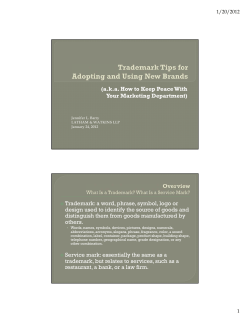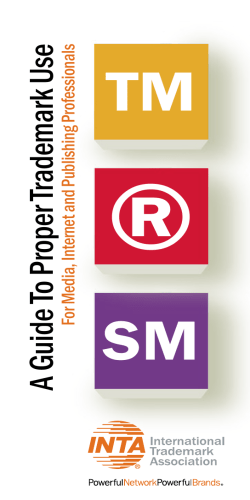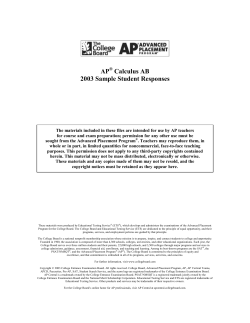
THE SUPREME COURT OF APPEAL OF SOUTH AFRICA JUDGMENT
THE SUPREME COURT OF APPEAL OF SOUTH AFRICA JUDGMENT REPORTABLE Case No: 503/2013 In the matter between: ROODEZANDT KO-OPERATIEWE WYNMAKERY LTD APPELLANT and ROBERTSON WINERY (PTY) LTD REGISTRAR OF TRADEMARKS Neutral citation: FIRST RESPONDENT SECOND RESPONDENT Roodezandt Ko-operatiewe Wynmakery Ltd v Robertson Winery (Pty) Ltd & another (503/13) [2014] ZASCA 173 (19 November 2014). Coram: Brand, Maya, Shongwe, Theron JJA et Meyer AJA Heard: 10 November 2014 Delivered: 19 November 2014 Summary: Trademarks Act 194 of 1993 – Register of trademarks rectified by removal of the appellant‟s trademark „Robertson Hills‟ on the basis that it is so similar to the first respondent‟s marks containing the word component „Robertson‟ that it is likely to deceive or cause confusion as contemplated by sub-sections 10(12) and 10(14) of the Act. 2 ___________________________________________________________________ ORDER ___________________________________________________________________ On appeal from: North Gauteng High Court, Pretoria (Mavundla J sitting as court of first instance): (a) The appeal is dismissed with costs. (b) Save for the amendment in para (c), the order of the high court is confirmed. (c) Paragraph 2 of the high court‟s order is amended to read as follows: „That the removal of the registration is made in terms of s 24 of the Trademarks Act 194 of 1993 and deemed to be with effect from the date of application for its removal on 19 January 2012.‟ ___________________________________________________________________ JUDGMENT ___________________________________________________________________ Brand JA (, Maya, Shongwe, Theron JJA et Meyer AJA concurring): [1] This appeal arises from the application of s 24(1) of the Trademarks Act 194 of 1993 (the Act) which allows for the rectification of the trademarks register, inter alia, by removing an entry wrongly made or wrongly remaining on the register. The appellant is Roodezandt Ko-operatiewe Wynmakery Ltd (Roodezandt). The first respondent is Robertson Winery (Pty) Ltd (the Winery). The Registrar of Trademarks, who was cited as the second respondent in this court and in the court a quo, abided the decision of the court on both occasions. Roodezandt is the proprietor of the trademark Robertson Hills, registered in class 33 in respect of alcoholic beverages, except beer. Proceedings began when the Winery brought an application in the North Gauteng High Court for the removal of this trademark in terms of s 24 of the Act. The court a quo, Mavundla J, granted the order sought with costs, but afforded Roodezandt leave to appeal to this court against his judgment and order. [2] Roodezandt‟s trademark was filed on 25 February 2008. In terms of s 29(1) of the Act that is therefore deemed to be the date of registration. It is common cause that, for the purpose of deciding whether or not the entry of that trademark was 3 wrongly made, we must look at the factual position prevailing at that date, irrespective of when the certificate of registration was issued. As at that date the Winery was the proprietor of three registered trademarks which included the name Robertson, all in class 33 and thus pertaining, amongst other things, to wine. The first of these was registered in 1997. It is a composite label, consisting inter alia of the words „Robertson Winery‟. The second of these marks was registered in 2002. It consists of a word mark „Robertson Vineyards‟. It is registered subject to the disclaimer that its registration „shall give no rise to the exclusive use of the geographical name Robertson where used bona fide as an indication of origin‟. The third mark consists of the word „Robertsoner‟ and was registered in 2004. To complete the picture, the Winery is also the registered holder of the trademark „William Robertson‟ again in class 33. But this was filed on 1 August 2008, ie five months after the effective date of Roodezandt‟s mark. [3] Apart from these registered marks, affidavits tendered by the Winery testified that it is an award winning winery which had been producing and distributing wines under the Robertson Winery label since 1941, ie 56 years before it applied for the registration of its first Robertson mark. By way of example, its wine sales increased from 197 878 cases of 12 x 750ml bottles in 2000, to 271 694 cases in 2002, to 451 397 cases in 2007 and to 1 068 740 cases in 2010. Annexed to these affidavits were a whole range of South African publications showing extensive advertising by the Winery of its Robertson Winery products. Moreover, the Winery pointed out that its wines are the only ones in relation to which the word Robertson has ever been used in respect of wine to identify the producer. Although Roodezandt nominally denied these allegations in its answering affidavit, these denials were self-evidently bald and Roodezandt plainly could proffer no evidence to contradict the Winery‟s contentions of its acquired reputation in the „Robertson Winery‟ mark. [4] As to the relevant legal principles, it appears to be well established that an application for rectification in terms of s 24 under the rubric „an entry wrongly made‟ can rely on any of the grounds on which opposition to registration could have been made (see eg Webster and Page South African Law of Trademarks 4 ed para 13.16.1). These include the negative attributes which would render a trademark unregisterable in terms of s 10 of the Act. With reference to the grounds 4 contemplated in s 10, the Winery initially relied upon a number of sub-sections, but in argument before us, confined itself to sub-section 10(12) and 10(14). What these two sub-sections have in common is that they proscribe the registration of a mark which would be likely to deceive or cause confusion, either in general or with reference to another registered mark. Hence it was common cause in argument before us that, whichever of these sub-sections were relied upon, the outcome of the appeal hinges on a comparison of Roodezandt‟s trademark with the marks relied upon by the Winery for similarity, so as to establish whether the former is likely to deceive or cause confusion. „Deception‟ will result, so it has been held, when the similarity were to cause members of the purchasing public to assume that the goods bearing the two competing trademarks come from the same source. „Confusion‟, on the other hand, would occur if these members of the public will be caused to wonder if the goods had a common origin (see eg Oude Meester Groep Bpk v SA Breweries Ltd; SA Breweries Ltd v Distillers Corporation (SA) Ltd 1973 (4) SA 145 (W) at 160H). [5] The fundamental enquiry is therefore whether Roodezandt‟s Robertson Hills mark so resembles the Winery‟s marks incorporating the term „Robertson‟ that, if the competing marks are all used in relation to wine, such use would be likely to cause deception or confusion. That determination involves a value judgment (see eg Cowbell AG v ICS Holdings Ltd 2001 (3) SA 941 (SCA) para 10). Considerations that could assist in the exercise of this value judgment have been proposed in numerous decided cases. One of these cases is Laboratoire Lachartre SA v Armour-Dial Incorporated 1976 (2) SA 744 (T) in which Colman J sounded the following note of caution (at 746B-E): „We have had ample time for full consideration and close comparison of the two trademarks with which we are concerned. These advantages, however, carry their own dangers. They have caused us to look at the trademarks with far greater care than they would be looked at by the members of the public whose probable reactions we are required to assess, and with a far keener awareness of similarities and dissimilarities than such people would probably have as they go about their daily lives. What we have now to do is, therefore, to transport ourselves, notionally, from the court-room or the study, to the market place. We must try to look at the marks as they will be seen, if they are both in fair and normal commercial use, by the hypothetical consumers of [wine]. Those will be people of many races and degrees of education, having varied gifts, interests 5 and talents. We are not to postulate the consumer of “phenomenal ignorance or extraordinarily defective intelligence”. . . We are to consider a person of average intelligence and proper eyesight, buying with ordinary caution.‟ [6] Most, if not all, of these considerations seem to find application in the present context. Other principles of comparison which have become crystallised in earlier decisions of this court which I find to be pertinent, include the following: (a) A likelihood of confusion does not only arise when every person interested or concerned in the class of goods for which the trademark has been registered could probably be deceived or confused. It also arises if the probabilities establish that a substantial number of such persons will be deceived or confused. (b) The concept of deception or confusion is not limited to inducing in the minds of these interested persons the erroneous belief or impression that the two competing products are those of the objector or that there is a connection between these two products. A likelihood of confusion is also established when it is shown that a substantial number of persons will probably be confused as to the origin of the products or the existence or non-existence of such a connection. (c) The determination of the likelihood of confusion involves a comparison between the two competing marks, having regard to the similarities and differences in the two and an assessment of the impact it would have on the average type of customer who is likely to purchase the kind of goods to which the marks are applied. (d) The marks must not only be considered side by side, but also separately. (e) It must be borne in mind that the ordinary purchaser may encounter goods bearing one mark with an imperfect recollection of the other. (f) If each of the competing marks contains a main or dominant feature or idea, the likely impact made by this dominating feature on the mind of the customer must be taken into account. This is so because marks are remembered by some significant or striking feature rather than by the photographic recollection of the whole. (See eg Plascon-Evans Paints Ltd v Van Riebeeck Paints (Pty) Ltd 1984 (3) SA 623 (A) at 640G-641E; Puma AG Rudolf Dassler Sport v Global Warming (Pty) Ltd 2010 (2) SA 600 (SCA) para 8; and Adidas AG & another v Pepkor Retail Ltd 2013 BIP 203 (SCA) paras 20-23.) 6 [7] Roodezandt‟s trademark, Robertson Hills, is clearly not identical to either Robertson Winery or Robertson Vineyards. Yet all these marks contain a common element, the term Robertson. Moreover, it is clear to me that this common element at the same time constitutes the dominant component of all three. After all, the suffix, „Hills‟ in itself seems to be as non-distinctive as „Winery‟ and „Vineyards‟. On the face of it and having regard to the crystallised principles of comparison to which I have referred, Roodezandt‟s mark therefore seems to create the likelihood of deception or confusion. [8] But, Roodezandt argued, Robertson is not a constructed or invented word finding distinctiveness in itself. It is the name of a town, and also the name of a defined production area in terms of s 11(3)(a) of the Liquor Products Act 60 of 1989. In this light, so Roodezandt contended, it was not open to the Winery to arrogate for itself the exclusive use of an ordinary geographical term „Robertson‟ in the trademark sense. [9] The answer to this line of argument, so it seems to me, is that although Robertson is not a constructed or invented word, but the name of a town, this does not necessarily mean that it could never acquire distinctiveness with reference to wine. The example that comes to mind is the one given by Harms DP in Century City Apartments Property Services CC v Century City Property Owners’ Association 2010 (3) SA 1 (SCA) para 33, of Windhoek as distinctive with reference to beer, albeit that it is also the capital of Namibia. Where, as in this case, the name „Robertson‟ had been used exclusively with reference to the wine of a specific producer for a period in excess of 60 years, I can see no reason why the Windhoek example would not apply. Moreover, what is clear to me, and in fact it was conceded, that Roodezandt is not using the word Robertson in its label „Robertson Hills‟ with reference to the town, but in order to distinguish its wines from others, ie as a trademark. [10] As to the fact that Robertson is the name of a defined production area for wine in accordance with the wine of origin scheme (the WO scheme) which was established in terms of the Liquor Products Act, this court had the opportunity on two occasions to express itself on the relationship between trademarks, on the one hand, and the WO scheme on the other. That was in Groupe LFE (SA) (Pty) Ltd v 7 Swartland Winery Ltd (467/09) [2011] ZASCA 4 (4 March 2011) and in Mettenheimer v Zonquasdrift Vineyards 2014 (2) SA 204 (SCA). In Mettenheimer the following is said (in paras 19 and 20): „According to well-established principle, a trademark serves as a badge of origin, in the sense that it identifies and guarantees the trade origin of the goods to which it applies . . . But in the wine industry a trademark in respect of wine serves to guarantee the origin of the wine only. The badge of origin in respect of the grapes from which that wine is made is provided by the wine of origin scheme (WO scheme).‟ And: „The WO scheme is governed by regulations promulgated . . . in terms of s 14 of the Liquor Products Act 60 of 1989. It emanates from the recognition in the wine industry that the “terroir” or area where the grapes are grown has a significant bearing on the wine made from these grapes.‟ [11] In Groupe LFE the word „Swartland‟ formed part of the respondent‟s registered trademark. It is also the name of a production area under the WO scheme. The appellant then used the word Swartland on its wine label to indicate that it was a wine of origin produced in the Swartland geographical area, as it was entitled to do in terms of the WO scheme. But, so this court held, on the facts of that case, the appellant also used the word Swartland as a trademark which constituted an infringement of the respondent‟s mark which, of course, it was not entitled to do. As I see it the facts of the present case a fortiori lead to a similar conclusion. Roodezandt does not even suggest that its Robertson Hills wines are produced as wines of origin in the Robertson geographical area. It uses the name Robertson exclusively as a badge of origin of the producer. And, because the Winery is doing the same, there is a likelihood of deception and confusion. [12] In all the circumstances I therefore agree with the finding by the court a quo that the Winery had succeeded in establishing the likelihood of confusion and deception of Roodezandt‟s trademark Robertson Hills with its marks containing the component Robertson. Hence I also agree that the Registrar of Trademarks should be ordered to rectify the register forthwith by the removal of Roodezandt‟s trademark „Robertson Hills‟ in class 33. 8 [13] The court a quo also ordered that the removal of Roodezandt‟s trademark is „deemed to be with effect from the date of entry of the relevant registration‟. Roodezandt contended, however, that there is no basis for making the order retrospective to that date. At best, so the argument went, the order could be effective as from the date of the application for removal of the trademark. Until such time as the order had been granted, so the argument went, the trademark remained validly registered. There appears to be no authority on this aspect. The Winery‟s counter argument was that in view of a finding that the trademark should never have been registered by virtue of s 10, the removal with retrospective effect from the outset is warranted. [14] Although I see the logic in the Winery‟s counter argument, I believe it may lead to consequences which could be substantially unfair. In this case it does not seem to matter because, as I understand it, Roodezandt had not yet used its registered mark. But what about the proprietor who had used its mark for a lengthy period prior to its removal under s 24? I find an analogy in what has become known in administrative law parlance as the Oudekraal principle (after the decision of this court in Oudekraal Estates (Pty) Ltd v Cape Town & others 2004 (6) 222 (SCA) para 31 in which it had first been established). In essence, this principle dictates that, since administrative decisions are often acted upon on the supposition that they were validly taken, they are accepted as valid, until challenged and set aside by a competent court. Whether or not the particular decision was indeed valid is of no consequence. Until challenged and set aside, its validity is accepted as a fact (see also eg Camps Bay Ratepayers’ and Residents’ Association v Harrison 2011 (4) SA 42 (CC) para 62). When applied to the removal of a trademark in terms of s 24 of the Act, the retrospective effect of that rectification can go no further than the time that its validity was formally challenged, which is the date of the application for its removal. [15] For these reasons: (a) The appeal is dismissed with costs. (b) Save for the amendment in para (c), the order of the high court is confirmed. (c) Paragraph 2 of the high court‟s order is amended to read as follows: 9 „That the removal of the registration is made in terms of s 24 of the Trademarks Act and deemed to be with effect from the date of application for its removal on 19 January 2012.‟ _________________ F D J BRAND JUDGE OF APPEAL 10 APPEARANCES: For the Appellant: R Michau SC Instructed by: Dyason Inc Pretoria c/o McIntyre & Van der Post Bloemfontein For the Respondent: A J Bester SC Instructed by: Ron Wheeldon Attorneys Johannesburg c/o Phatshoane Henney Bloemfontein
© Copyright 2025






![[NAME OF WINERY] BUSINESS PLAN](http://cdn1.abcdocz.com/store/data/000170642_1-f8951bff12f9bc2ffe971c40c9482866-250x500.png)


